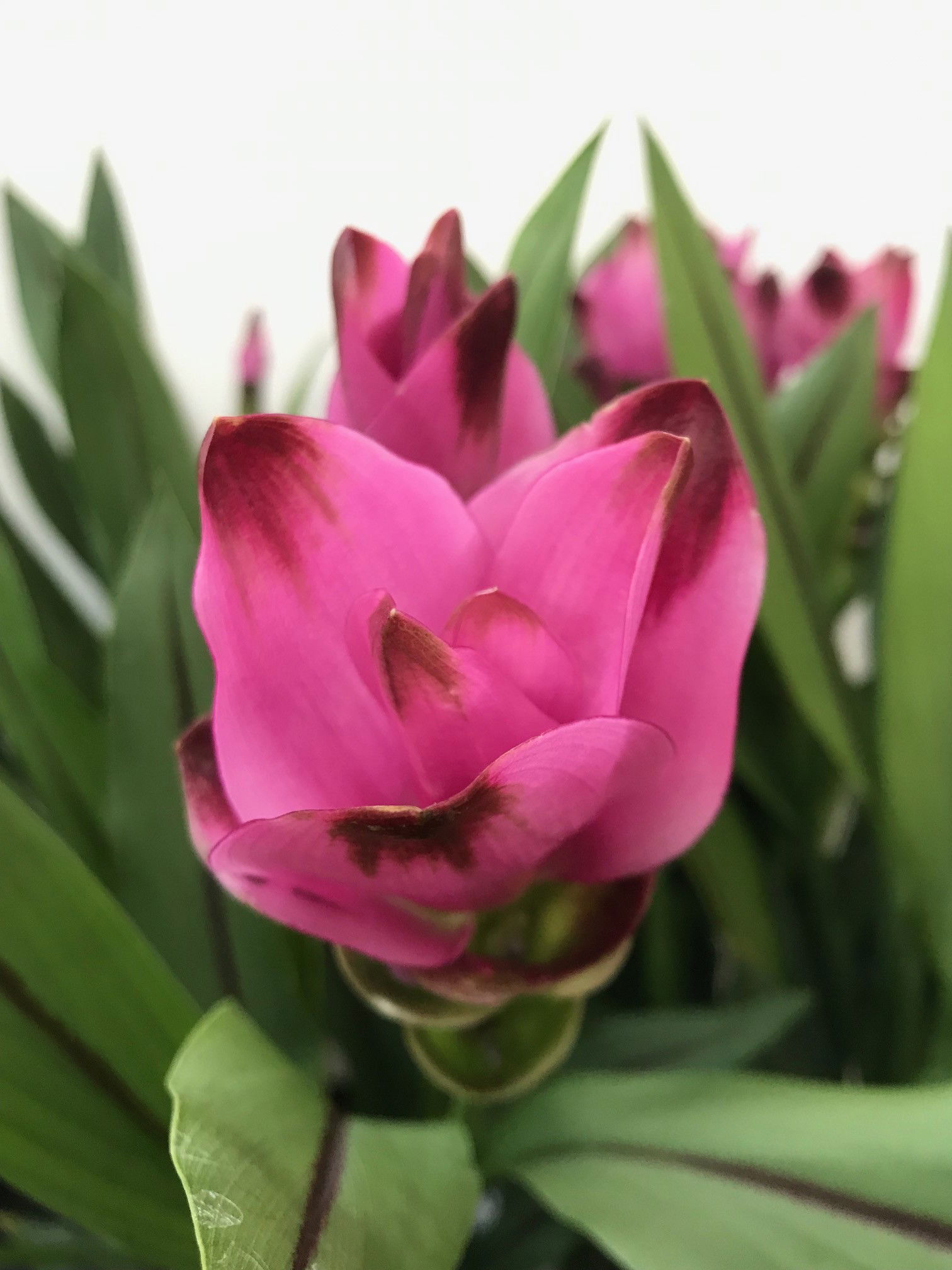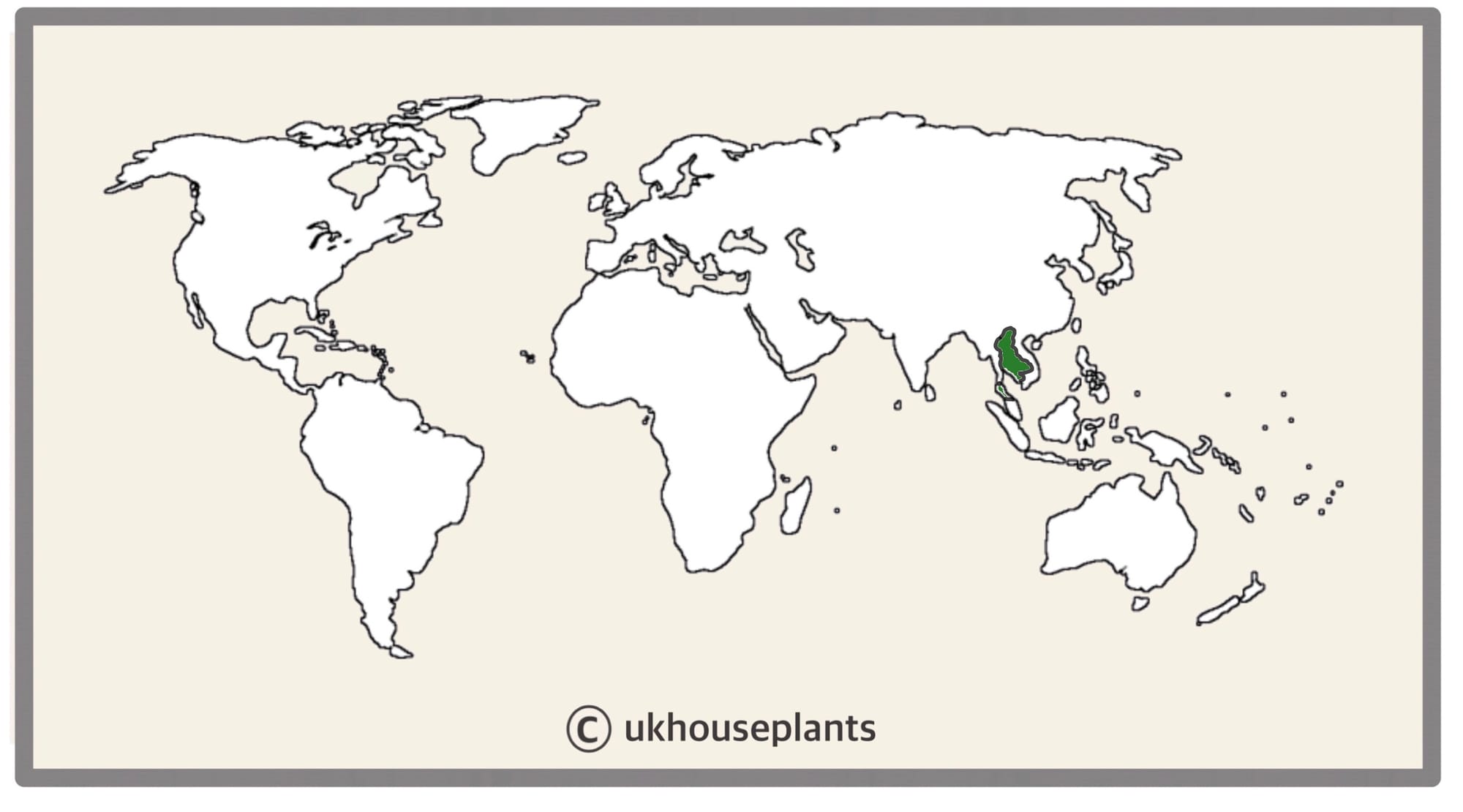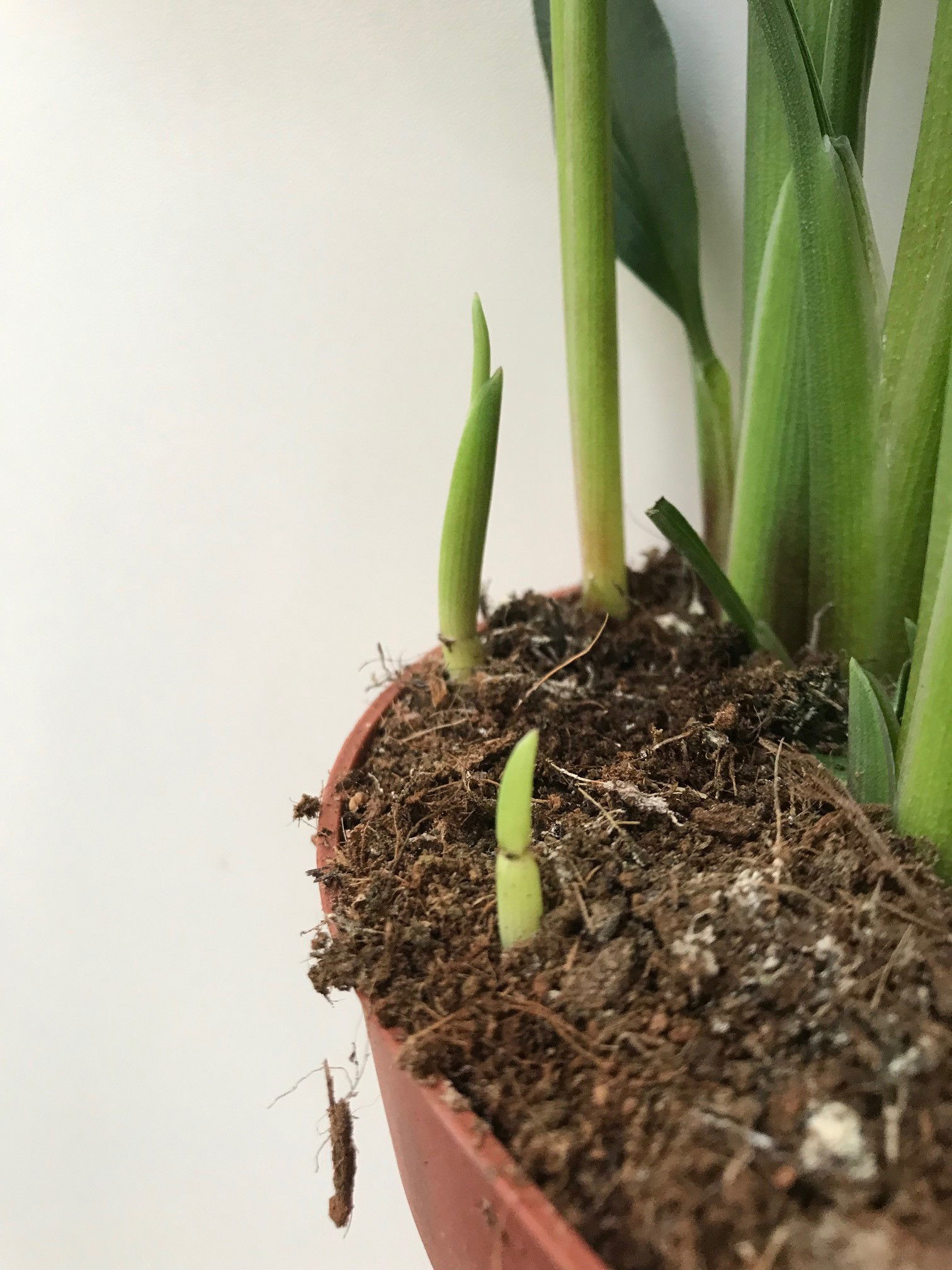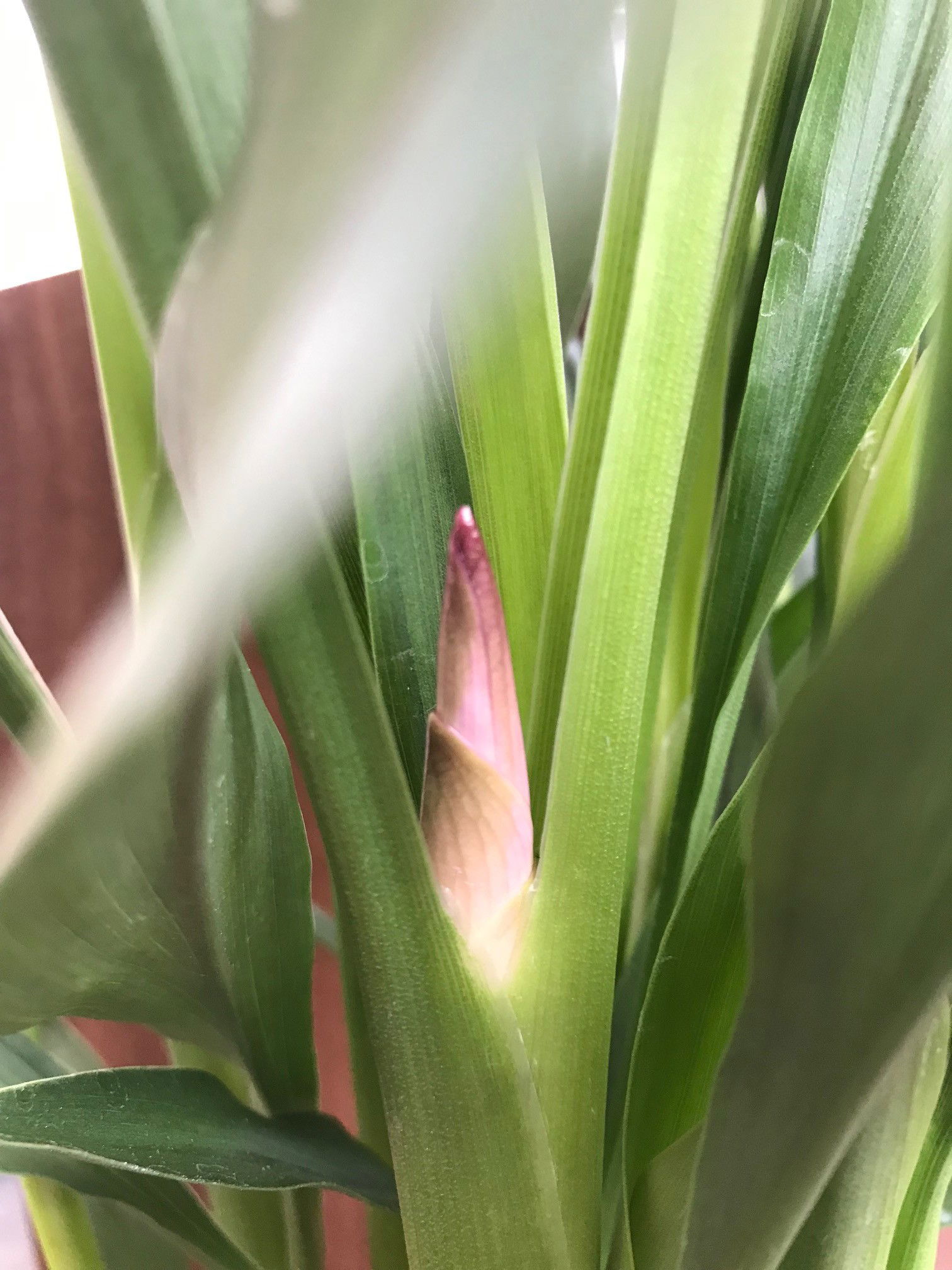
Curcuma alismatifolia
Contents
- Top Tips
- Location, Water, Humidity & Fertilisation
- Dormancy Period & Annual Flowers
- Common Issues
- Origins, Temperature, Propagation, Repotting & Toxicity.
Need the answer to a specific plant query? Book a 1-to-1 video call with Joe Bagley, the website's friendly author to overcome and address your niggling problem! Available on iMessage, WhatsApp, Facebook Messenger & more.
Top Tips & Info
- Care Difficulty - Moderate
- Provide a bright enough location which enables you to read a book without the use of artificial lighting. Those kept in deep shade are considerably more likely to develop shortened flowering times and even basal collapse.
- Allow the top third to dry out in between waters during the flowering process. Reduce this slightly in the autumn and winter to reinforce its dormancy, which in turn could entice a new show of blooms in the following summer.
- Introduce a pebble tray to increase the local humidity and slow the rates of drying soil.
- Fertilise once every two to four weeks using a 'Houseplant' labelled feed, depending on the season. Fertilise soil will help prolong the flowers' lifespan.
- Keep an eye out for basal collapse, which is caused by over-watering and possibly too little light. Scroll down to 'Common Issues' for more information on this.
- Keep an eye out for Mealybugs and Spider Mites that'll inhabit the cubbyholes of its foliage.
- Repot every three years using a 'Houseplant' labelled potting mix and the next sized pot with adequate drainage. This is the perfect chance to have a look at the root's health condition.
Location & Light - 🔸🔸
Locations that are too dark will entice basal rot, shorter flowering times and anaerobic soil to the mix, so it's essential to ace its environmental factors first. We'd recommend situating yours in a north-facing windowsill, or within two metres of an east, south or west-facing window to promote efficient levels of photosynthesis. If it's enough to light to read a newspaper, while having your back against the window, it'll be accepted by the Tulip. Alternatively, too much sunlight will lead to sun-scorch, resulting in yellowed leaves and stunted growth.
Water - 🔸🔸
During the growing period, allow the top third of the soil to dry out in between irrigations, reducing this further autumn and winter. For those situated in darker locations, water far less often than with those grown in brighter places to counteract the slowed photosynthesis and water-intake. Under-watering symptoms include yellowing or wilting leaves, flower loss, browning leaf-edges and slowed growth. These issues are usually due to either a much needed repot (see 'Repotting' section towards the bottom of the article for an explanation), too much sunlight or forgetfulness. Over-watering symptoms include root rot, basal collapse and rapidly declining health. Remove the root ball from the pot and inspect the roots for possible rot. Scroll down to 'Common Issues' for more information on addressing this problem.
Humidity - 🔸🔸
Average room humidity is more than enough to occupy a Siam Tulip, as too high humidity and poor air circulation will result in powdery mildew. Do not mist the flowers as this will cause botrytis petal blight that can spread quickly if not dealt with accordingly.
Fertilisation - 🔸🔸
Use a fertiliser high in potassium to prolong its flowers during the festive period, at fortnightly intervals - an excellent example would be a Tomato Feed. Regular fertilisers, for instance, BabyBio or Miracle-Gro, will still do the job but will favour foliar growth instead. For the rest of the year, a standard fertiliser can be used to supplement the plant, at monthly intervals.
Dormancy Care & Annual Flowers
Siam Tulip inflorescences are achieved when its dormancy irrigations are reduced by half; those who have a cooler room without artificial light at night will also be on the upper-hand. The following steps should be performed from late summer through until early spring when they enter their dormancy. Keep the roots pot-bound to add further stress onto the specimen, which in turn will significantly heighten the chance of flowering. Blooms will generally appear in the late spring to summer but may occur at any given time.
N. B. - Each individual stem (rhizomatous offset) will only flower once, so if you only have already-flowered foliage, you'll have to wait until the following year for new growths to appear from beneath the soil. New stems will develop in the spring and maybe ready to bloom within the same season if your care skills are up to scratch.
The following steps should be taken from early autumn until the end of winter.
Sunlight & Location
Be sure to provide a bright location with little to no direct sunlight. Although the winter rays won't necessarily hurt the plant, be careful not to fall in the trap of sun-scorch and severe dehydration.
Avoid the use of artificial lighting at night or locations that boast temperatures higher than 18℃ (64℉).
Hydration
Reduce waters so that at least half of the soil becomes dry. It's essential to keep them on the drier side to life, as they'll think that hard times are ahead and therefore will need to pass its genes on to the next generation.
Occasional Feeds
Whilst in bloom, use a Tomato feed to provide monthly nourishment of potassium; fertilisation isn't needed until the first flower stalk develops from the plant.
Reduce Everything
This is to remind you that everything needs to be reduced - especially the temperature.
Temperature
This is the most significant step; reduce the temperature down by around 5℃ compared to the summertime or place in a room that's between 16º - 20℃ (61º - 68℉). The drop in temperature should ideally last until the inflorescence finishes blooming, although it can still be transferred into the main house as long as it sits on a pebble tray. You'll be at a significant disadvantage if the ambient temperature is kept constant throughout the year, as Siam Tulips will only respond in locations that have daily fluctuations of around 4℃. Never exceed the minimum temperature as it may lead to plant death or yellowed foliage at a bare minimum.
Common Issues with Siam Tulips
Root rot is a common issue among specimens sat in too dark environments with prolonged soil moisture. Symptoms include rapidly yellowing leaves, mouldy soil, stunted growth and a rotten collapsed base. Take the plant out of the pot and inspect health below the compost line. If the roots sport a yellow tinge, you're good to go, but those that are brown and mushy must be addressed immediately. More information about managing root rot can be found on this link.
If your Tulip develops basal collapse, it may spell the end of its life. The rhizomes, which are located below the soil line and act like a modified stem, is the lifeline for a successful specimen, so any issues of rot will kill it outright. If yours has problems of this, be sure to take the plant out of the pot and inspect its roots. Prune away any rotten areas and check its base for a softened profile. Remove any individual plants that have a rotten bottom and repot the healthy specimens in a fresh batch of 'Houseplant' compost. Provide a brighter location and reduce the number of waters slightly to avoid further rot. Discard the plant if there is no sign of health below the soil line.
A dark location (shelves, etc.) will promote the vines to develop small or no juvenile leaves, giving the impression of 'leggy' or naked growth. The length between the nodes will also dramatically become larger, harvesting less energy that can be converted into sortable sugars. Be sure to increase the amount of indirect light somewhat, and give the specimen a gentle supplement of 'Houseplant' labelled feed to help with its stored energy.
Pests could arise at any time, with infestations starting from the original nursery or via contamination in your home. Spider Mites and Mealybugs to tend to be the usual inhabitants, with the first being minute and almost transparent, roaming the leaves in search of chlorophyll and a site to hide its eggs. The latter, however, will stand out much more, with white cottony webs developing across the foliage and stems. Thoroughly check the plant's cubbyholes before giving it the all-clear, or click on the appropriate links to learn more about eradicating these issues!
Curling leaves with crispy brown edges symbolise under-watering and possibly too much sunlight. As Siam Tulips tend to have extensive root systems, you may want to consider a transplant to reduce the number of waters with moister, fresh soil. Scroll down to 'Repotting' for more information!
Due to the species' sensitivity to chemicals, Leaf Shine shouldn't be used to improve the appearance of the foliage, and instead should be cleaned via a rinse of lukewarm water. Failure to do so may cause yellowed, mottled spots that cannot be undone.
A lack of flowers is caused by an insufficient dormancy period, where the temperatures are kept more or less the same over the year. Reduce the temperature by a couple of degrees over the autumn and winter months, along with fewer irrigations to ensure a well-spent dormancy. As spring arrives, the natural temperature will begin to increase, with this is being the perfect time to increase waters and fertilisation. Remember, the warmer the summer days are, the more likely a specimen is to reflower.
Origins
Siam Tulips or C. Alismatifolia are part of the Zingiberales order, which holds genera like Musa (banana palms), Strelitzia (Bird of Paradise) and Calathea and bare significant similarities due to their rhizomatous and stem structures. Siam Tulips originate from Thailand, Cambodia & Laos, and were first described by Carl Linnaeus back in the 1750s. The name, Curcuma, derives from the Sanskrit kuṅkuma, referring to turmeric which has been used in India for several centuries as a substitute for saffron. 'Alismatifolia' can be taken from ancient Greek to mean 'water plantain', nodding to the similarities of a different genus, Alisma, that grow along riverbeds and aquatic areas. 'Water plantains' is a common name for species within the Alisma genus.
 The Distribution of Curcuma alismatifolia.
The Distribution of Curcuma alismatifolia.
Temperature
15° - 24°C (64° - 75°F).
H1a (Hardiness Zone 13) - Must be grown indoors or under glass all year round. Never allow temperatures to dip below 15℃ (59℉) or permanent damage may occur in the likes of flower loss, stunted growth and blackened or yellowed leaves.
Spread
Up to 0.7m in height and 0.4m in width. The ultimate height will take between 3 - 5 years to achieve.
Pruning & Maintenance
Remove yellowed or dying leaves and plant debris to encourage better growth and improve the all-round appearance. Pruning must be done with clean scissors or shears to reduce the chance of bacterial and fungal diseases; remember to make clean incisions as too much damage can shock the plant.
 New rhizomatous growth appearing above the soil line. Once this particular stem reaches maturity during summer, a large flower stalk will emerge from the centre until it bursts into life at its top.
New rhizomatous growth appearing above the soil line. Once this particular stem reaches maturity during summer, a large flower stalk will emerge from the centre until it bursts into life at its top.
Propagation
Via Seed & Basal Offset Division.
Offset Division (Pups) (Easy) - Separating the basal offsets into their own pot will not only expand your plant collection, but it'll also slow the process of becoming pot bound. The best time to divide is during the spring or summer, with the pup's height surpassing 10cm. Gently brush away some of the soil to gain better access to the pup's base, where its roots will be housed. While using a clean pair of secateurs or scissors, cut the cord with at least two root strands attached to its base. Set the pup in an appropriate-sized pot with adequate drainage and a houseplant-labelled compost. The ideal location would provide bright, indirect light and temperatures above 15℃ (59℉). Maintain evenly moist soil, allowing the top third to dry out in between hydrations. After a month or two, you'll be able to treat it like a matured specimen by using the care tips above.
Flowers
Siam Tulips will develop at the top of each stem as they reach maturity. The flowering period can last up to two months towards the end of summer, with the stems dying back once its blooms are spent. As mentioned above, most of the stems will die back over winter, readying itself for the upcoming spring. Keep the potted rhizomes in a warm, dryish location until new nodes appear just above the soil line.
 Once the stem has matured, a flower stalk (pictured) will develop directly at the top that will bloom for up to three weeks.
Once the stem has matured, a flower stalk (pictured) will develop directly at the top that will bloom for up to three weeks.
Repotting
Repot every two years in spring using a 'Houseplant' labelled potting mix and the next sized pot with adequate drainage. Siam Tulips are far better potbound for several years due to the heightened risk of root rot and repotting-issues (like transplant shock), so only repot if you feel it's wholly necessary - restricted root growth will also increase the chance of blooms, too. Deformed plastic pots caused by the underground growths are standard and won't necessarily require a bigger pot.
Hydrate the plant 24hrs before the tinkering with the roots to prevent the risk of transplant shock. For those situated in a darker location, introduce an extra amount of perlite and grit into the deeper portion of the pot to downplay over-watering risks. Click on this link for a detailed step-by-step guide on transplantation, or via this link to learn about repotting with root rot.
Book a 1-to-1 video call with Joe Bagley if you'd like a personal guide to repotting your houseplant. This will include recommending the right branded-compost and pot size, followed by a live video call whilst you transplant the specimen for step-by-step guidance and answer any further questions!
Pests & Diseases
Keep an eye out for mealybugs, spider mites, scale, fungus gnats & root mealybugs that'll locate themselves in the cubbyholes and undersides of the leaves, with the exception of the latter in soil. Common diseases associated with Siam Tulips are root rot, leaf-spot disease, botrytis, rust, powdery mildew & southern blight - click here to learn more about these issues.
Toxicity
This plant is classified as poisonous to pets, so if small sections are eaten, vomiting, nausea, and a loss of appetite may occur. Consumption of large quantities must be dealt with quickly; acquire medical assistance for further information.
Retail Locations
Online Stores.
Book a 1-to-1 Call with Joe Bagley
If you need further advice with your houseplants, book an advice call with ukhouseplants' friendly and expert writer today! This can be done via a video or audio call on most apps, including Facebook, FaceTime & Skype. A ten-minute call costs £3.99 (US$5), or £14.99 for thirty minutes. You can ask multiple questions, including queries on plants, pests, terrariums, repotting advice and anything in between. Please consider supporting this service to keep ukhouseplants thriving!